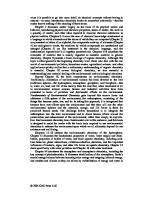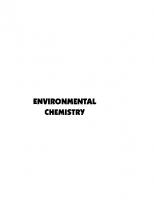The Chemistry of Environmental Engineering 9781119707745, 1119707749
The focus of this book is the chemistry of environmental engineering and its applications, with a special emphasis on th
364 94 277MB
English Pages 336 [335] Year 2020
Cover......Page 1
Title Page......Page 5
Copyright Page......Page 6
Contents......Page 7
Preface......Page 13
1.1.1 Metallocene Poly(ethylene)......Page 15
1.1.2 Geomembranes......Page 20
1.2.1 Syndiotactic Poly(styrene)......Page 21
1.3.1 Blends of Poly(ethylene terephthalate) and Poly(phenylene sulfide)......Page 25
1.4.1 Silicon Nanocrystals and Silicon-Polymer Hybrids......Page 26
1.4.2 Surfactants......Page 27
1.5 Self-healing Polymers......Page 39
1.5.1 Multiphasic Copolymer......Page 40
1.5.3 Microcapsule Based Self-Healing......Page 42
1.5.4 Tunable Mechanical Strengths......Page 43
1.5.5 Bioinspired Pathways......Page 44
1.6.1 Natural Fiber Reinforced Polymer Composites......Page 46
1.6.2 Shape Memory Systems......Page 49
1.6.3 Smart Polymers......Page 55
1.7.1 Preparation Methods......Page 56
1.7.2 Polymer Foams......Page 62
1.7.3 Porous Polymer Monoliths......Page 64
1.7.4 Concrete......Page 65
References......Page 68
2.2 Impact response of Hybrid Carbon/Glass Fiber Reinforced Polymer Composites......Page 77
2.3.1 Real Elastic Network Theory......Page 78
2.3.2 Interpenetrating Polymer Network Hydrogels......Page 79
2.3.4 Asphalt......Page 80
2.4 Bacterial Adhesion......Page 84
2.4.1 Influence of Stiffness......Page 86
2.4.2 Bioactive Sulfone Polymers......Page 88
2.4.3 Functionalized Dopamine......Page 96
2.4.4 Sub-micrometer Structures......Page 97
2.4.5 Mechanically Modulated Microgel Coatings......Page 99
2.4.6 Conductive Polymers......Page 100
2.4.7 Reverse Osmosis Membranes......Page 101
References......Page 108
3.2 Additive Manufacturing......Page 113
3.3.1 Vinyl Macromonomers of Poly(styrene)......Page 115
3.3.2 Ultrasound Atom Transfer Radical Polymerization......Page 116
3.3.3 Near-Infrared Sensitized Photoinduced Atom-Transfer Radical Polymerization......Page 117
3.4 Reversible Addition-Fragmentation Chain Transfer Polymerization......Page 119
3.5 Enzymatic Polymerization......Page 122
3.6.1 Nonthermal Plasma Technology......Page 125
3.7 Friction Welding......Page 127
3.7.1 ABS and Poly(amide)s......Page 128
3.8 Interfacial Engineering......Page 131
3.9.1 Mineralization of Plasma Treated Polymer Surfaces......Page 132
3.9.2 Wetting Properties......Page 133
3.9.3 Vapor Phase Graft Polymerization......Page 135
3.9.4 Effect of Plasma Treatment Frequency......Page 137
3.9.5 Plasma Treatment in Textile Industry......Page 138
3.9.6 Antimicrobial Surfaces......Page 140
3.9.7 Non-Thermal Plasma Treatment of Agricultural Seeds......Page 144
3.9.8 Special Materials......Page 146
References......Page 150
4.1.2 Secondary Recycling......Page 157
4.1.4 Quaternary Recycling......Page 158
4.1.5 Melt Filtration......Page 159
4.1.6 Hydrothermal Recycling......Page 162
4.1.7 Quality of Postconsumer Plastics......Page 163
4.2.1 Poly(propylene)Waste......Page 165
4.2.2 PET Bottles......Page 166
4.2.3 Engineering Epoxy Resin......Page 170
4.2.4 Carbon Nanotube-Filled Polycarbonate......Page 171
4.2.5 Asphalt Compositions......Page 172
4.2.6 Tire Rubbers......Page 174
References......Page 175
5.1 Properties and Contaminants......Page 179
5.1.1 Microplastics......Page 181
5.1.2 Organic Dyes......Page 182
5.1.3 Pharmaceutical Residues in Wastewater......Page 183
5.1.4 Passively Aerated Biological Filter......Page 185
5.2.1 Activated Carbon......Page 187
5.2.2 Adsorbent Regeneration......Page 190
5.2.3 Ultrasound-assisted treatment......Page 191
5.2.4 Praseodymium Molybdate......Page 192
5.2.5 Biosorbents......Page 193
References......Page 195
6.1 Pesticide Carriers......Page 197
6.2 PCL Nanocapsules......Page 198
6.3 Self-Decontamination Mechanisms......Page 199
6.4 Controlled Release of Pesticides......Page 200
6.4.1 PVA-Starch Composite Films......Page 201
6.4.3 PBSU and PLA Nanofibers......Page 202
6.4.4 Poly(3-hydroxybutyrate)......Page 203
6.5.1 Biosensor for Dichlorvos......Page 204
6.5.3 Voltammetric Method for Ethyl Paraoxon......Page 206
6.5.4 Nitrogen Doped Graphene Electrode......Page 207
6.5.5 Molecularly Imprinted Sensor......Page 208
6.5.6 Ecotoxicity Evaluation......Page 209
References......Page 211
7.1 Photovoltaic Materials......Page 213
7.3 Energy Storage and Dielectric Applications......Page 214
7.3.1 Polymer Nanocomposites......Page 215
7.3.2 Multiwall Carbon Nanotubes......Page 221
7.4.1 Circularly Polarized Light......Page 222
7.4.2 Polymer Types......Page 224
7.4.3 Color Management......Page 227
7.4.4 Light-Emitting Electrochemical Cells......Page 236
7.5 Fast Charging Batteries......Page 242
7.5.1 Charging Stages......Page 244
7.5.3 Lithium-Ion Batteries......Page 246
7.6 Electrical Power Cable Engineering......Page 248
7.6.2 High Voltage Alternating Current Cables for Subsea Transmission......Page 249
References......Page 252
8.1.1 GUI Software Packages......Page 259
8.1.3 Microbial Growth......Page 260
8.2.2 Marine Polysaccharides......Page 261
8.3 Protein Engineering......Page 263
8.4.1 Biosensors......Page 264
8.4.2 Electronic Tongues......Page 267
8.4.3 Microwave Methods......Page 268
8.4.4 Optoelectronic Sensor......Page 270
8.4.5 Digital Image Analysis......Page 271
8.5 Ultrasonic Methods......Page 272
8.5.2 Composition of Meat......Page 273
8.5.3 Flour Quality......Page 275
8.5.4 Porosity of Bread......Page 276
8.5.5 Dairy Products......Page 277
References......Page 279
9.2 Porous Bioresorbable Polymers......Page 283
9.3.1 Biomedical Materials......Page 288
9.3.2 Electrically Conducting Polymer......Page 293
9.3.3 Bioactive Glass......Page 294
9.3.4 Glass-based Coatings......Page 301
9.3.5 Hard Tissue Implants......Page 304
9.3.6 Membranes......Page 308
9.3.7 Textile-based Technologies......Page 309
9.3.8 Improvement of Cell Adhesion......Page 310
9.3.9 Solvent Free Fabrication......Page 311
9.3.10 Stereolithographic 3D Printing......Page 312
9.3.11 Extrusion-Based 3D Printing......Page 313
References......Page 316
Acronyms......Page 321
Chemicals......Page 325
General Index......Page 329
EULA......Page 335
Recommend Papers

- Author / Uploaded
- Fink
- Johannes Karl(Contributor)
File loading please wait...
Citation preview
The Chemistry of Environmental Engineering
Scrivener Publishing 100 Cummings Center, Suite 541J Beverly, MA 01915-6106 Publishers at Scrivener Martin Scrivener ([email protected]) Phillip Carmical ([email protected])
The Chemistry of Environmental Engineering Materials, Processing and Applications
Johannes Karl Fink Montanuniversität Leoben, Austria
This edition first published 2020 by John Wiley & Sons, Inc., 111 River Street, Hoboken, NJ 07030, USA and Scrivener Publishing LLC, 100 Cummings Center, Suite 541J, Beverly, MA 01915, USA © 2020 Scrivener Publishing LLC For more information about Scrivener publications please visit www.scrivenerpublishing.com. All rights reserved. No part of this publication may be reproduced, stored in a retrieval system, or transmitted, in any form or by any means, electronic, mechanical, photocopying, recording, or otherwise, except as permitted by law. Advice on how to obtain permission to reuse material from this title is available at http://www.wiley.com/go/permissions. Wiley Global Headquarters 111 River Street, Hoboken, NJ 07030, USA For details of our global editorial offices, customer services, and more information about Wiley products visit us at www.wiley.com. Limit of Liability/Disclaimer of Warranty While the publisher and authors have used their best efforts in preparing this work, they make no rep resentations or warranties with respect to the accuracy or completeness of the contents of this work and specifically disclaim all warranties, including without limitation any implied warranties of merchant- ability or fitness for a particular purpose. No warranty may be created or extended by sales representa tives, written sales materials, or promotional statements for this work. The fact that an organization, website, or product is referred to in this work as a citation and/or potential source of further informa tion does not mean that the publisher and authors endorse the information or services the organiza tion, website, or product may provide or recommendations it may make. This work is sold with the understanding that the publisher is not engaged in rendering professional services. The advice and strategies contained herein may not be suitable for your situation. You should consult with a specialist where appropriate. Neither the publisher nor authors shall be liable for any loss of profit or any other commercial damages, including but not limited to special, incidental, consequential, or other damages. Further, readers should be aware that websites listed in this work may have changed or disappeared between when this work was written and when it is read. Library of Congress Cataloging-in-Publication Data ISBN 978-1-119-70774-5 Cover image: Pixabay.Com Cover design by Russell Richardson Set in size of 11pt and Minion Pro by Manila Typesetting Company, Makati, Philippines Printed in the USA 10 9 8 7 6 5 4 3 2 1
Contents Preface xi 1 Special Polymers 1 1.1 Poly(ethylene) 1 1.1.1 Metallocene Poly(ethylene) 1 1.1.2 Geomembranes 6 1.2 Poly(styrene) 7 1.2.1 Syndiotactic Poly(styrene) 7 1.3 Poly(ethylene terephthalate) 11 1.3.1 Blends of Poly(ethylene terephthalate) and Poly(phenylene sulfide) 11 1.4 Silicones 12 1.4.1 Silicon Nanocrystals and Silicon-Polymer Hybrids 12 1.4.2 Surfactants 13 1.5 Self-healing Polymers 25 1.5.1 Multiphasic Copolymer 26 1.5.2 Hydrophobic Coatings 28 1.5.3 Microcapsule Based Self-Healing 28 1.5.4 Tunable Mechanical Strengths 29 1.5.5 Bioinspired Pathways 30 1.6 Fibers and Smart Polymers 32 1.6.1 Natural Fiber Reinforced Polymer Composites 32 1.6.2 Shape Memory Systems 35 1.6.3 Smart Polymers 41 1.7 Porous Materials 42 1.7.1 Preparation Methods 42 1.7.2 Polymer Foams 48 1.7.3 Porous Polymer Monoliths 50 1.7.4 Concrete 51 References 54 v
vi Contents 2 Special Properties of Polymers 63 2.1 Viscoelasticity 63 2.2 Impact response of Hybrid Carbon/Glass Fiber Reinforced Polymer Composites 63 2.3 Mechanical Properties 64 2.3.1 Real Elastic Network Theory 64 2.3.2 Interpenetrating Polymer Network Hydrogels 65 2.3.3 Flax Fabric Reinforced Polymer 66 2.3.4 Asphalt 66 2.4 Bacterial Adhesion 70 2.4.1 Influence of Stiffness 72 2.4.2 Bioactive Sulfone Polymers 74 2.4.3 Functionalized Dopamine 82 2.4.4 Sub-micrometer Structures 83 2.4.5 Mechanically Modulated Microgel Coatings 85 2.4.6 Conductive Polymers 86 2.4.7 Reverse Osmosis Membranes 87 References 94 3 Processing Methods 99 3.1 Radiation Processing 99 3.2 Additive Manufacturing 99 3.3 Atom Transfer Radical Polymerization 101 3.3.1 Vinyl Macromonomers of Poly(styrene) 101 3.3.2 Ultrasound Atom Transfer Radical Polymerization 102 3.3.3 Near-Infrared Sensitized Photoinduced Atom-Transfer Radical Polymerization 103 3.4 Reversible Addition-Fragmentation Chain Transfer Polymerization 105 3.5 Enzymatic Polymerization 108 3.6 Surface Patterning 111 3.6.1 Nonthermal Plasma Technology 111 3.7 Friction Welding 113 3.7.1 ABS and Poly(amide)s 114 3.8 Interfacial Engineering 117 3.9 Plasma Treatment 118 3.9.1 Mineralization of Plasma Treated Polymer Surfaces 118 3.9.2 Wetting Properties 119 3.9.3 Vapor Phase Graft Polymerization 121 3.9.4 Effect of Plasma Treatment Frequency 123 3.9.5 Plasma Treatment in Textile Industry 124
Contents vii 3.9.6 Antimicrobial Surfaces 126 3.9.7 Non-Thermal Plasma Treatment of Agricultural Seeds 130 3.9.8 Special Materials 132 References 136 4 Recycling 143 4.1 Recycling Methods 143 4.1.1 Primary Recycling 143 4.1.2 Secondary Recycling 143 4.1.3 Tertiary Recycling 144 4.1.4 Quaternary Recycling 144 4.1.5 Melt Filtration 145 4.1.6 Hydrothermal Recycling 148 4.1.7 Quality of Postconsumer Plastics 149 4.2 Materials 151 4.2.1 Poly(propylene) Waste 151 4.2.2 PET Bottles 152 4.2.3 Engineering Epoxy Resin 156 4.2.4 Carbon Nanotube-Filled Polycarbonate 157 4.2.5 Asphalt Compositions 158 4.2.6 Tire Rubbers 160 References 161 5 Wastewater Treatment 165 5.1 Properties and Contaminants 165 5.1.1 Microplastics 167 5.1.2 Organic Dyes 168 5.1.3 Pharmaceutical Residues in Wastewater 169 5.1.4 Passively Aerated Biological Filter 171 5.2 Adsorbents 173 5.2.1 Activated Carbon 173 5.2.2 Adsorbent Regeneration 176 5.2.3 Ultrasound-assisted treatment 177 5.2.4 Praseodymium Molybdate 178 5.2.5 Biosorbents 179 References 181 6 Pesticides 6.1 Pesticide Carriers 6.2 PCL Nanocapsules 6.3 Self-Decontamination Mechanisms
183 183 184 185
viii Contents 6.4 Controlled Release of Pesticides 6.4.1 PVA-Starch Composite Films 6.4.2 PLA Nanofibers 6.4.3 PBSU and PLA Nanofibers 6.4.4 Poly(3-hydroxybutyrate) 6.5 Sensors 6.5.1 Biosensor for Dichlorvos 6.5.2 Biosensor for Carbaryl 6.5.3 Voltammetric Method for Ethyl Paraoxon 6.5.4 Nitrogen Doped Graphene Electrode 6.5.5 Molecularly Imprinted Sensor 6.5.6 Ecotoxicity Evaluation References
186 187 188 188 189 190 190 192 192 193 194 195 197
7 Electrical Uses 199 7.1 Photovoltaic Materials 199 7.2 Solar Cells 200 7.3 Energy Storage and Dielectric Applications 200 7.3.1 Polymer Nanocomposites 201 7.3.2 Multiwall Carbon Nanotubes 207 7.3.3 High-Temperature Dielectric Materials 208 7.4 Light Emitting Polymers 208 7.4.1 Circularly Polarized Light 208 7.4.2 Polymer Types 210 7.4.3 Color Management 213 7.4.4 Light-Emitting Electrochemical Cells 222 7.5 Fast Charging Batteries 228 7.5.1 Charging Stages 230 7.5.2 Increasing the Cycling Lifetime 232 7.5.3 Lithium-Ion Batteries 232 7.6 Electrical Power Cable Engineering 234 7.6.1 Carbon Nanotube Cables 235 7.6.2 High Voltage Alternating Current Cables for Subsea Transmission 235 7.6.3 Biodegradable Polymer Cables 238 References 238 8 Food Engineering 8.1 Software 8.1.1 GUI Software Packages 8.1.2 Food Ingredient Tracing
245 245 245 246
Contents ix 8.1.3 Microbial Growth 246 8.2 Materials 247 8.2.1 Microbial Biopolymers 247 8.2.2 Marine Polysaccharides 247 8.3 Protein Engineering 249 8.4 Instrumentation and Sensors 250 8.4.1 Biosensors 250 8.4.2 Electronic Tongues 253 8.4.3 Microwave Methods 254 8.4.4 Optoelectronic Sensor 256 8.4.5 Digital Image Analysis 257 8.5 Ultrasonic Methods 258 8.5.1 Special Applications 259 8.5.2 Composition of Meat 259 8.5.3 Flour Quality 261 8.5.4 Porosity of Bread 262 8.5.5 Dairy Products 263 References 265 9 Medical Uses 9.1 Drug Delivery 9.2 Porous Bioresorbable Polymers 9.3 Tissue Engineering 9.3.1 Biomedical Materials 9.3.2 Electrically Conducting Polymer 9.3.3 Bioactive Glass 9.3.4 Glass-based Coatings 9.3.5 Hard Tissue Implants 9.3.6 Membranes 9.3.7 Textile-based Technologies 9.3.8 Improvement of Cell Adhesion 9.3.9 Solvent Free Fabrication 9.3.10 Stereolithographic 3D Printing 9.3.11 Extrusion-Based 3D Printing References
269 269 269 274 274 279 280 287 290 294 295 296 297 298 299 302
Index 307 Acronyms 307 Chemicals 311 General Index 315
Preface Preface This book focuses on the chemistry of environmental engineering and applications. Special attention is receiving the use of polymers in this field. Polymers can be created with special properties, such as viscoelasticity, interpenetrating networks, and others. Also, a polymer modified asphalt with special properties can be created. Further, another issue is the creation of polymers with special bacterial adhesion properties. The formation of reverse osmosis membranes that do not show biofouling are of importance for water purification procedures. In another chapter, special processing methods are detailed, such as atom transfer radical polymerization, enzymatic polymerization, plasma treatment, and several other methods. Recycling methods are now important environmental issues for several types of materials, such as PET Bottles, tire rubbers, asphalt compositions, and other engineering resins. Also, wastewater treatment has been detailed. Here, the types of contaminants, such as microplastics, organic dyes, pharmaceutical residues are described and also special methods for proper removal are detailed. Also the types of adsorbents, including also biosorbents are detailed. Still another important issue for environmental engineering chemistry are pesticides. Here also the development and fabrication of special sensors for the detection of certain pesticides are detailed. In a further special chapter, electrical uses are detailed. These include photovoltaic materials, solar cells, energy storage and dielectric applications, light emitting polymers, and fast charging batteries. The recent issues of food engineering, such as food ingredient tracing, protein engineering, biosensors and electronic tongues have been detailed. Finally, medical uses have been described. These fields include drug delivery, tissue engineering, porous coatings and also the special methods of fabrication of such materials. xi
xii Preface The text focuses mainly on the literature of the past decade. Beyond education, this book will serve the needs of industry engineers and specialists who have only a passing contact with the plastics and composites industries but need to know more.
How to Use This Book Utmost care has been taken to present reliable data. Because of the vast variety of material presented here, however, the text cannot be complete in all aspects, and it is recommended that the reader study the original literature for more complete information. The reader should be aware that mostly US patents have been cited where available, but not the corresponding equivalent patents in other countries. For this reason, the author cannot assume responsibility for the completeness, validity or consequences of the use of the material presented herein. Every attempt has been made to identify trademarks; however, there were some that the author was unable to locate. Index There are three indices: an index of acronyms, an index ofchemicals, and a general index. In the index of chemicals, compounds that occur extensively, e.g., “acetone,” are not included at every occurrence, but rather when they appear in an important context.
Acknowledgements I am indebted to our university librarians, Dr. Christian Hasenhüttl, Margit Keshmiri, Friedrich Scheer, Christian Slamenik, Renate Tschabuschnig, and Elisabeth Groß for support in literature acquisition. I also want to express my gratitude to all the scientists who have carefully published their results concerning the topics dealt with herein. This book could not have been otherwise compiled. Last, but not least, I want to thank the publisher, Martin Scrivener, for his abiding interest and help in the preparation of the text. In addition, my thanks go to Jean Markovic, who made the final copyedit with utmost care. Johannes Fink Leoben
µ
Also of Interest Check out these other books by the author published by Scrivener Publishing The Chemistry of Environmental Engineering By Johannes Karl Fink Published 2020. ISBN 978-1-119-70774-5 The Chemistry of Bio-based Polymers, second edition By Johannes Karl Fink Published 2019. ISBN 978-1-119-68131-1 Liquid Silicone Rubber By Johannes Karl Fink Published 2019. ISBN 978-1-119- 63133-0 Functional Synthetic Polymers By Johannes Karl Fink Published 2019. ISBN 978-1-119-59202-0 3D Industrial Printing with Polymers By Johannes Karl Fink Published 2018. ISBN 978-1-119-55526-1 Polymer Waste Management By Johannes Karl Fink Published 2018. ISBN 978-1-119-53608-6 Materials, Chemicals and Methods for Dental Applications By Johannes Karl Fink Published 2018. ISBN 978-1-119-51031-4 Fuel Cells, Solar Panels, and Storage Devices Materials and Methods By Johannes Karl Fink Published 2018. ISBN 978-1-119-48010-5 Chemicals and Methods for Conservation and Restoration Paintings, Textiles, Fossils, Wood, Stones, Metals, and Glass By Johannes Karl Fink Published 2017. ISBN 978-1-119-41824-5
Additives for High Performance Applications Chemistry and Applications By Johannes Karl Fink Published 2017. ISBN 978-1-119-36361-3 Metallized and Magnetic Polymers By Johannes Karl Fink Published 2016. ISBN: 978-1-119-24232-1 Marine, Waterborne, and Water-Resistant Polymers Chemistry and Applications By Johannes Karl Fink Published 2015. ISBN 978-1-119-018486-7 The Chemistry of Printing Inks and Their Electronics and Medical Applications By Johannes Karl Fink Published 2015. ISBN 978-1-119-04130-6 The Chemistry of Bio-based Polymers By Johannes Karl Fink Published 2014. ISBN 978-1-118-83725-2 Polymeric Sensors and Actuators By Johannes Karl Fink Published 2012. ISBN 978-1-118-41408-8 Handbook of Engineering and Specialty Thermoplastics Part 1: Polyolefins and Styrenics By Johannes Karl Fink Published 2010. ISBN 978-0-470-62483-5 Handbook of Engineering and Specialty Thermoplastics Part 2: Water Soluble Polymers By Johannes Karl Fink Published 2011. ISBN 978-1-118-06275-3 A Concise Introduction to Additives for Thermoplastic Polymers By Johannes Karl Fink. Published 2010. ISBN 978-0-470-60955-2
WILEY END USER LICENSE AGREEMENT Go to www.wiley.com/go/eula to access Wiley’s ebook EULA.






![Environmental Chemistry [7ed]](https://ebin.pub/img/200x200/environmental-chemistry-7ed.jpg)


